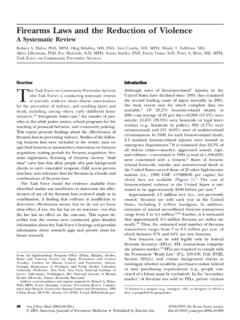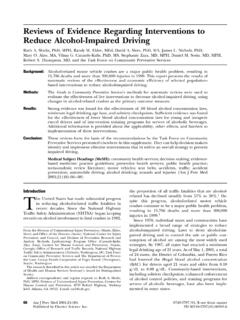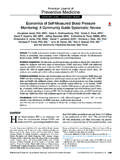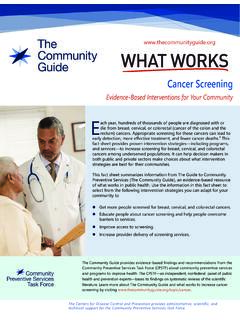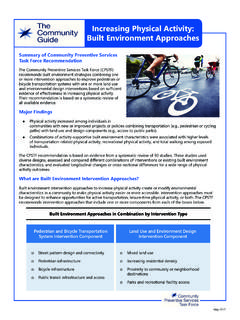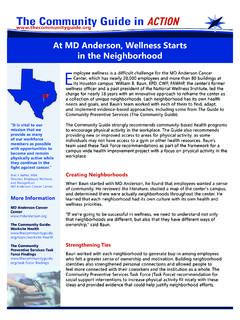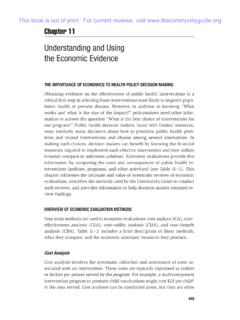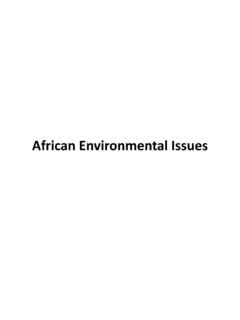Transcription of Changing Risk Behaviors and Addressing Environmental ...
1 Part IChanging Risk Behaviors and Addressing Environmental ChallengesChapter 1 TobaccoReducing Tobacco Use InitiationRECOMMENDED INTERVENTIONSI ncreasing the Unit Price for Tobacco Products10 Mass Media Education Campaigns When Combined with Other Interventions12 Restricting Minors Access to Tobacco Products:Community Mobilization When Combined with Additional Interventions (Stronger Local Laws Directed at Retailers, Active Enforcement of Retailer Sales Laws, Retailer Education with Reinforcement)17 INSUFFICIENT EVIDENCE TO DETERMINE EFFECTIVENESS OF THE INTERVENTION*Restricting Minors Access to Tobacco Products:Sales Laws Directed at Tobacco Retailers to Reduce Illegal Sales to Minors When Implemented Alone20 Laws Directed at Minors Purchase, Possession,or Use of Tobacco Products When Implemented Alone21 Active Enforcement of Sales Laws Directed at Retailers When Implemented Alone22 Retailer Education with Reinforcement and Information on Health Consequences When Implemented Alone23 Retailer Education without Reinforcement When Implemented Alone24 Community Education about Minors Access to Tobacco Products When Implemented Alone25 Increasing Tobacco Use CessationRECOMMENDED INTERVENTIONSI ncreasing the Unit Price for Tobacco Products27 Mass Media Education Campaigns Combined with Other Interventions29 Healthcare Provider Reminder Systems35 Healthcare Provider Reminder Systems with Provider Education.
2 With or without Client Education37 Reducing Client Out-of-Pocket Costs for Effective Cessation Therapies42 Multicomponent Interventions That Include Client Telephone Support443*Insufficient evidence means that we were not able to determine whether or not the intervention Task Force approved the recommendations in this chapter in 1999 2000. The research on whichthe findings are based was conducted between 1976 and May 2000. This information with the ex-ception of reviews of approaches to reduce tobacco use through interventions to restrict minors accessto tobacco products has been previously published in the American Journal of Preventive Medicine[2001; 20(2S): 10 15 and 16 66] and the MMWR Recommendations and Reports series [2000; 49( ):1 11]. The information on restricting minors access to tobacco products is being prepared EVIDENCE TO DETERMINE EFFECTIVENESS OF THE INTERVENTION*Mass Media Education Cessation Series32 Mass Media Education Cessation Contests34 Healthcare Provider Education Alone39 Healthcare Provider Feedback and Assessment41 Reducing Exposure To Environmental Tobacco SmokeRECOMMENDED INTERVENTIONSS moking Bans and Restrictions48 INSUFFICIENT EVIDENCE TO DETERMINE EFFECTIVENESS OF THE INTERVENTION*Community Education to Reduce Exposure to Environmental Tobacco Smoke in the Home51 Tobacco use is the leading cause of preventable illness and death in the as a cause of multiple cancers, heart disease, stroke, com-plications of pregnancy, and chronic obstructive pulmonary disease,2tobaccouse is responsible for 430,000 deaths per year among adults, and direct medi-cal costs are in the range of $50 $73 billion per nearly four decades of policies, regulations, educational efforts.
3 And increasing information on the negative health effects of tobacco use andthe positive health benefits of cessation, tobacco use remains unacceptablyhigh. In 2002, an estimated million adults in the United States (nearlyone in four adults) use and disparities in tobacco-relatedmorbidity and mortality vary by region, level of education, socioeconomicstatus, race, gender, and ,5 Individuals below the poverty line, forexample, are more likely to smoke than individuals at or above the povertyline ( compared with ).4By level of education, adults who hadearned a General Educational Development (GED) diploma had the highestprevalence ( ) of smoking; people with masters, professional, and doc-toral degrees had the lowest prevalence ( ).4 The prevalence of smokingamong American Indians and Alaska Natives ( ) is higher than that ofother racial and ethnic tobacco use results in true drug dependence in most users, makingattempts to quit difficult and relapses users make multipleattempts to 2002, an estimated million current smokers ( )had stopped smoking for at least one day during the preceding 12 monthsbecause they were trying to stop smoking cessation sig-nificantly reduces the immediate and subsequent risks of tobacco-relatedmorbidity and mortality,8,9most tobacco users do not receive assistance the acquisition of this costly, chronic dependence is clearly de-4 Risk Behaviors and Environmental Challengessirable.
4 However, tobacco use initiation and the transition from experimen-tation to addiction are not easy to prevent because they occur primarily inadolescence, when individuals are more susceptible to influences from fam-ily, friends, peers, society, and the tobacco industry that encourage among 8th, 10th, and 12th graders increased dramatically from1991 to 1997 and then declined just as dramatically from 1997 to 2003. For ex-ample, prevalence of current smoking among high school seniors was 1991, increased to by 1997, and declined to by rates of smoking prevalence among young adults aged 18 24 years ( 2002), in addition to reflecting those who started smoking in high school,may also indicate an increase in tobacco use initiation among this to Environmental tobacco smoke (ETS) is a recognized cause ofheart disease and accounts for an estimated 3000 lung cancer deaths per yearamong infants and children, exposure to ETS causes middleear infections and effusions, exacerbates 400,000 1,000,000 cases of asthmaannually, and causes 150,000 300,000 cases of lower respiratory tract infec-tions each health effects of exposure to ETS have prompted theincreasing implementation of public and private policies that restrict median level of cotinine (a marker for exposure to tobacco smoke)
5 Among nonsmokers declined 70% from 1988 1991 to 1999 2000, suggestinga dramatic reduction in exposure of the general population to ETS overthis time period. However, substantial gender, racial, and age disparities in ex-posure are evident, with children, men, and African Americans having higherexposure to ETS continues to occur in workplaces and pub-lic areas without smoking bans or effective restrictions and in households inwhich smoking indoors is AND RECOMMENDATIONS FROM OTHER ADVISORY GROUPSThe interventions reviewed in this chapter can be useful in reaching many ofthe tobacco control objectives in Healthy People 201015(Table 1 1). In thefield of tobacco control, many groups have published useful guidelines. Tohelp summarize this information, we published an article in 200116compar-ing the Community Guidepopulation-based recommendations with reviewsand recommendations produced by other groups, including the Surgeon Gen-eral s office, the United States Preventive Services Task Force (which pub-lishes the Guide to Clinical Preventive Services17), and the Cochrane Collabo-ration.
6 Another good source for readers interested in information on variousclinical guidelines is Treating Tobacco Use and Dependence: Clinical PracticeGuideline6; some information from that report is also summarized in 1 Healthy People 201015 Objectives Related to Tobacco Use and Environmental Tobacco Smoke Exposure2010 ObjectivePopulation BaselineObjectiveTobacco Use in Population GroupsReduce cigarette smoking by Adults24% (1998)12%adults (Objective 27 1a)Reduce use of tobacco productsAdolescents40% (1999)21%by adolescents (in the past month)(27 2a)Reduce the initiation of tobacco Children/ Developmentaluse among children and adolescentsadolescents (27 3)Increase (delay) the average Adolescents12 years old 14 years oldage of first tobacco use by (1997)adolescents (aged 12 17 years) (27 4a)Cessation and TreatmentIncrease the percentage of Adults41% (1998a)75%smokers stopping smoking for a day or longer (27 5)Among females aged 18 49 Pregnant women14% (1998)30%years, increase smoking cessation in pregnant women in the first trimester of pregnancy (27 6)
7 Among adolescents in grades Adolescents76% (1999)84%9 12, increase the percentage of ever-daily smokers who try to quit (27 7)Increase in insurance coverage of evidence-based treatment for nicotine dependency: in managed care All75% (1997 98) 100%organizations: (27 8a) in Medicaid programs 24 states (1998) 51 statesin states and the District of Columbia (27 8b)Exposure to Secondhand Smoke (ETS)Among children aged 6 years, Young children27% (1994)10%reduce the proportion of chil-dren who live in homes in which someone smokes inside the house 4 days per week (27 9)Reduce the proportion of non-Nonsmokers65% (1988 94a) 45%smokers aged 4 years with a serum cotinine level ng/mL (27 10)6 Table 1 ObjectivePopulation BaselineObjectiveExposure to Secondhand Smoke (ETS) (continued)Increase the proportion of Schools37% (1994)100%smoke-free and tobacco-free middle, junior high, and senior high schools (27 11) Increase the proportion of Employees79% (1998 99) 100%worksites (with 50 workers) with formal smoking policies that prohibit smoking or limit it to separately ventilated areas (27 12) Increase the number of states (All 1998)(For all)plus the District of Columbia with laws on smoke-free air.
8 In private workplaces All1 state51 states(27 13a) in public workplaces 13 states(27 13b) in restaurants (27 13c)3 states on public transportation 16 states(27 13d) in day-care centers (27 13e)22 states in retail stores (27 13f) 4 statesSocial and Environmental ChangesIncrease the number of states Minors0 states (1998)51 states(including the District of Colum-bia) with a 5% sales rate of tobacco products to minors (27 14a)Increase the number of states Minors34 states (1998) 51 states(including the District of Colum-bia) that can suspend or revoke state licenses for violation of laws prohibiting the sale of tobacco to minors (27 15)Eliminate tobacco advertising Adolescents/Developmentaland promotions that influence young adultsadolescents and young adults (27 16) Increase the proportion of ado-(All 1998)lescents who disapprove of smoking: among 8th graders Adolescents80%95% for all(27 17a)continued next page7 METHODSM ethods used for the reviews are summarized in Chapter 10.
9 Specific meth-ods used in the systematic reviews of tobacco use prevention and control havebeen described elsewhere16,18 20and are available at The logic framework depicting the conceptual approach used inthese reviews is presented in Figure 1 EFFICIENCYA systematic review of available economic evaluations was conducted foreach recommended intervention, and a summary of each review is presentedwith the related intervention. The methods used to conduct these economicsreviews are summarized in Chapter Behaviors and Environmental ChallengesTable 1 ObjectivePopulation BaselineObjectiveSocial and Environmental Changes (continued) among 10th graders 75%(27 17b) among 12th graders 69%(27 17c)Increase the number of tribes, AllDevelopmentalterritories, and states and the District of Columbia with com-prehensive, evidence-based to-bacco control programs (27 18)Reduce the number of states All30 states (1998) 0 statesthat have laws preempting stronger tobacco control (in the areas of clean indoor air, minors access laws, or market-ing) (27 19)Reduce the toxicity of tobacco AllDevelopmentalproducts by establishing a regu-latory structure to monitor toxicity (27 20) Increase the combined federal All$ (1998)$2and average state tax (per pack) on cigarettes (27 21a) Increase the combined federal Developmentaland average state tax on spit tobacco (27 21b)
10 AAge adjusted for the year 2000 standard AND FINDINGSThis section presents a summary of the findings of the systematic reviewsconducted to determine the effectiveness of the selected interventions in thistopic area. We evaluated interventions to address three goals essential to to-bacco prevention and control efforts: decreasing the number of people whostart using tobacco products (tobacco use initiation), increasing the numberof tobacco users who quit (tobacco use cessation), and reducing exposuresamong nonsmokers to Environmental tobacco smoke (ETS).Reducing Tobacco Use InitiationThe interventions in our reviews are designed to change knowledge, atti-tudes, and tobacco use among children, adolescents, and young adults. Mostadults who use tobacco products began in adolescence, and nicotine addic-tion develops during the first few years of and adolescentsmay perceive tobacco use to be a normal peer and adult behavior , and canoften act on this belief because tobacco products are readily available and or delaying experimentation with tobacco or prevent-ing the transition from experimentation to regular use are the major goals ofthe interventions we reviewed: increasing the unit price for tobacco products,Tobacco9 Figure 1 framework illustrating the conceptual approach used in systematic reviews oftobacco use.
